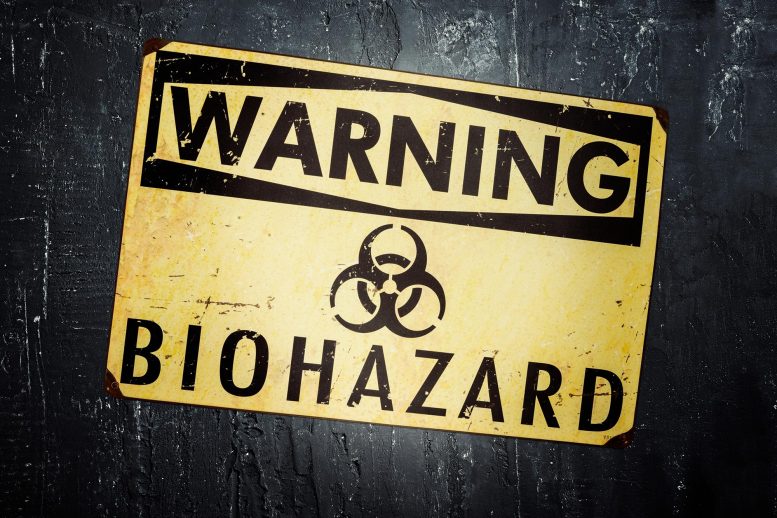Emerging Evidence Suggests COVID-19 Originated in a Lab
A study published in the peer-reviewed academic journal Risk Analysis suggests a higher probability of COVID-19 originating from a laboratory rather than naturally.
Research points to an unnatural origin as the likely source for COVID-19.
The origin of COVID-19 is highly debated – most studies have focused on a zoonotic origin, but research from the journal Risk Analysis, examined the likelihood of an unnatural origin (i.e. from a laboratory.)
The results indicate a greater likelihood of an unnatural than natural origin of the virus. The researchers used an established risk analysis tool for differentiating natural and unnatural epidemics, the modified Grunow-Finke assessment tool (mGFT) to study the origin of COVID-19. This risk assessment cannot prove the specific origin of COVID-19 but shows that the possibility of a laboratory origin cannot be easily dismissed.
The modified Grunow-Finke assessment tool (mGFT) is a methodology designed to evaluate the likelihood of whether an epidemic originated from natural or unnatural (e.g., laboratory) sources. This tool is an adaptation of the original Grunow-Finke assessment tool, developed to assess the risk and origin of infectious disease outbreaks more systematically.
The mGFT operates by analyzing specific criteria and evidence related to the outbreak in question. These criteria may include the geographical distribution of the disease, the presence of the pathogen in laboratories, the natural reservoir of the virus, the timing of the outbreak relative to other events, and any unusual patterns in the disease’s spread or manifestation.
Each criterion is scored based on the available evidence, and these scores are then compiled to provide an overall assessment. The tool helps researchers, epidemiologists, and public health officials to systematically evaluate the data and determine the most probable origin of an outbreak, supporting more informed decisions on public health responses and investigations into disease origins.
Reference: “Use of a risk assessment tool to determine the origin of severe acute respiratory syndrome coronavirus 2 (SARS-CoV-2)” by Xin Chen, Fatema Kalyar, Abrar Ahmad Chughtai and Chandini Raina MacIntyre, 15 March 2024, Risk Analysis.
DOI: 10.1111/risa.14291
Abstract
The origin of severe acute respiratory syndrome coronavirus 2 (SARS-CoV-2) is contentious. Most studies have focused on a zoonotic origin, but definitive evidence such as an intermediary animal host is lacking. We used an established risk analysis tool for differentiating natural and unnatural epidemics, the modified Grunow–Finke assessment tool (mGFT) to study the origin of SARS-COV-2. The mGFT scores 11 criteria to provide a likelihood of natural or unnatural origin. Using published literature and publicly available sources of information, we applied the mGFT to the origin of SARS-CoV-2. The mGFT scored 41/60 points (68%), with high inter-rater reliability (100%), indicating a greater likelihood of an unnatural than natural origin of SARS-CoV-2. This risk assessment cannot prove the origin of SARS-CoV-2 but shows that the possibility of a laboratory origin cannot be easily dismissed.

A study published in the peer-reviewed academic journal Risk Analysis suggests a higher probability of COVID-19 originating from a laboratory rather than naturally.
Research points to an unnatural origin as the likely source for COVID-19.
The origin of COVID-19 is highly debated – most studies have focused on a zoonotic origin, but research from the journal Risk Analysis, examined the likelihood of an unnatural origin (i.e. from a laboratory.)
The results indicate a greater likelihood of an unnatural than natural origin of the virus. The researchers used an established risk analysis tool for differentiating natural and unnatural epidemics, the modified Grunow-Finke assessment tool (mGFT) to study the origin of COVID-19. This risk assessment cannot prove the specific origin of COVID-19 but shows that the possibility of a laboratory origin cannot be easily dismissed.
The modified Grunow-Finke assessment tool (mGFT) is a methodology designed to evaluate the likelihood of whether an epidemic originated from natural or unnatural (e.g., laboratory) sources. This tool is an adaptation of the original Grunow-Finke assessment tool, developed to assess the risk and origin of infectious disease outbreaks more systematically.
The mGFT operates by analyzing specific criteria and evidence related to the outbreak in question. These criteria may include the geographical distribution of the disease, the presence of the pathogen in laboratories, the natural reservoir of the virus, the timing of the outbreak relative to other events, and any unusual patterns in the disease’s spread or manifestation.
Each criterion is scored based on the available evidence, and these scores are then compiled to provide an overall assessment. The tool helps researchers, epidemiologists, and public health officials to systematically evaluate the data and determine the most probable origin of an outbreak, supporting more informed decisions on public health responses and investigations into disease origins.
Reference: “Use of a risk assessment tool to determine the origin of severe acute respiratory syndrome coronavirus 2 (SARS-CoV-2)” by Xin Chen, Fatema Kalyar, Abrar Ahmad Chughtai and Chandini Raina MacIntyre, 15 March 2024, Risk Analysis.
DOI: 10.1111/risa.14291
Abstract
The origin of severe acute respiratory syndrome coronavirus 2 (SARS-CoV-2) is contentious. Most studies have focused on a zoonotic origin, but definitive evidence such as an intermediary animal host is lacking. We used an established risk analysis tool for differentiating natural and unnatural epidemics, the modified Grunow–Finke assessment tool (mGFT) to study the origin of SARS-COV-2. The mGFT scores 11 criteria to provide a likelihood of natural or unnatural origin. Using published literature and publicly available sources of information, we applied the mGFT to the origin of SARS-CoV-2. The mGFT scored 41/60 points (68%), with high inter-rater reliability (100%), indicating a greater likelihood of an unnatural than natural origin of SARS-CoV-2. This risk assessment cannot prove the origin of SARS-CoV-2 but shows that the possibility of a laboratory origin cannot be easily dismissed.
